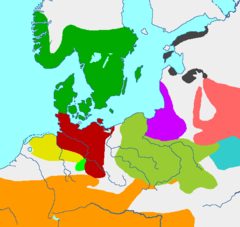Milograd culture


The Milograd culture was an archaeological culture of the early Iron Age from the 7th to the 1st century BC. In the area of today's Belarus and Ukraine .
The ethnic classification is unclear, early Baltic groups are possible.
Distribution area
The distribution area of the Milograd culture was on the Pripyat and the upper Dnepr between Beresina and Ros .
The name derives from the Milograd castle settlement in the Retschyzky rajon in the Woblasz Homel .
Neighboring cultures were the line pottery culture and the Dnieper Dvina culture in the north, the Juchnowo culture in the east, the Chernolis culture in the south and the Pomeranian face urn culture in the west.
Settlements
The Milograd culture can be divided into two groups: on the Pripyat and on the Upper Dnieper. The Dnieper group settled about 2–5 km from the right fertile bank of the Dnieper and 10 km or more from the left marshy bank. The Pripyat group built their settlements on elevations in the marshland of the Pripyat, which they could use as protection and retreat areas.
There were fortified and unfortified settlements. The fortified ones were different in form and function in both groups and were protected by wood-earth walls. There were castle settlements with several independent ramparts (Garoschkau, Milograd).
The houses were round, oval or rectangular and had an area of 12 to 16 m². They were sunk into the earth or at ground level ( Pripyat group ). They had window openings and were partly different from each other,
economy
The basis of life was agriculture and animal husbandry, as well as hunting and fishing. Iron and bronze were processed, weaving and pottery were developed. The ceramic was ornamented. Utensils such as tools, weapons and jewelry were made of iron, stone, leather, bronze, and amber.
The material culture shows influences from neighboring cultures. So arrows of Scythian manufacture were found. The manner in which grave goods are buried in barrows is also Scythian influenced. Celtic traces are also traceable, iron and bronze objects of Central European origin were found in a settlement near Gomel .
Funeral culture
Initially, burial mounds with a diameter of up to 22 meters piled on wooden structures were used as body graves. In some cases, rich grave goods were preserved. Later on, cremation was used in round or oval graves that were located within the settlements. Grave goods were also found here.
Succession cultures
Between the 3rd and 1st centuries BC The Milograd culture was slowly replaced by the Sarubinzy culture . By the 1st century BC Both cultures seem to have coexisted.
literature
- Sergej Evgenewitsch Rassadin: Milogradskaja kultura: areal, chronologia, etnos ( The Milograd culture: area, chronology, ethnos ). Minsk 2005
- MI Loschenkow: Gorodishcha milogradskoj kultury na territorii Belarusi ( Castle settlements of the Milograd culture in Belarus ). Minsk 2011
Remarks
- ↑ Marija Gimbutas , Die Balten, Munich 1983, cf. also WW Sedov , AR Mitrofanow
